In the diverse tapestry of Michigan’s avian realm, discover 11 captivating finch species that grace the state with their unique charm and distinct characteristics.
From the vibrant American Goldfinch to the nomadic Red Crossbill and the elusive Hoary Redpoll, each finch adds a splash of color and melody to Michigan’s landscapes.
This exploration unveils the intricacies of their lifestyles, habitats, and contributions to the state’s rich biodiversity.
Join us on a journey through Michigan’s woodlands, gardens, and skies to encounter the diverse array of these feathered wonders, showcasing nature’s brilliance in the form of these 11 different types of finches. Stay sharp.
11 Finches Of Michigan
Jump on a journey through the vibrant avian tapestry of Michigan, where a diverse array of finches graces the skies.
From the cheerful melodies of American Goldfinches to the unique bills of Red Crossbills and the striking plumage of Rose-breasted Grosbeaks, each species adds a touch of charm to Michigan’s rich birdlife, creating a symphony of colors and songs.
1. House Finch

- Scientific name: Haemorhous mexicanus
- Population: Abundant and widespread
- Life span: 2 to 7 years
- Size: 5 to 6 inches
- Weight: 0.7 to 1.1 ounces
- Wingspan: 8.7 to 9.8 inches
- Status: Least Concern
The House Finch, scientifically known as Haemorhous mexicanus, is a common sight in Michigan, thriving in various habitats. Their adaptability allows them to inhabit urban, suburban, and rural areas.
These small birds exhibit a diverse diet, feeding on seeds, fruits, and insects. With a lifespan ranging from 2 to 7 years, House Finches are social birds, often forming flocks, and their cheerful songs can be heard throughout the year.
Their plumage varies, with males displaying vibrant red coloring on their heads and throats. Females have a more subdued appearance, featuring streaked patterns.
These finches construct cup-shaped nests in various locations, including trees, shrubs, and even on buildings. Their association with humans is notable, as they readily use feeders in backyards.
This interaction makes them a favorite among birdwatchers. Despite occasional challenges from diseases like Mycoplasmal conjunctivitis, House Finches remain a resilient and adaptive species, contributing to the avian diversity of Michigan.
2. Purple Finch

- Scientific name: Haemorhous purpureus
- Population: Stable, with regional fluctuations
- Life span: 3 to 5 years
- Size: 5.5 to 7 inches
- Weight: 0.8 to 1.3 ounces
- Wingspan: 9.4 to 10.2 inches
- Status: Least Concern
The Purple Finch (Haemorhous purpureus) graces Michigan with its vibrant presence. While not as abundant as the House Finch, their stable population and striking plumage make them a captivating species. With a lifespan of 3 to 5 years, these finches exhibit sexual dimorphism.
Males boast a brilliant raspberry hue, while females showcase a more subdued brown and white coloration. Purple Finches prefer coniferous and mixed woodlands, where they forage for seeds, berries, and insects.
Their musical and melodious songs contribute to the symphony of Michigan’s birdlife, especially during the breeding season. These finches build cup-shaped nests in trees, utilizing twigs, grasses, and other materials.
While they may visit feeders, Purple Finches are more commonly found in natural settings. Their presence adds a touch of elegance to Michigan’s avian community, symbolizing the region’s biodiversity.
3. Pine Grosbeak
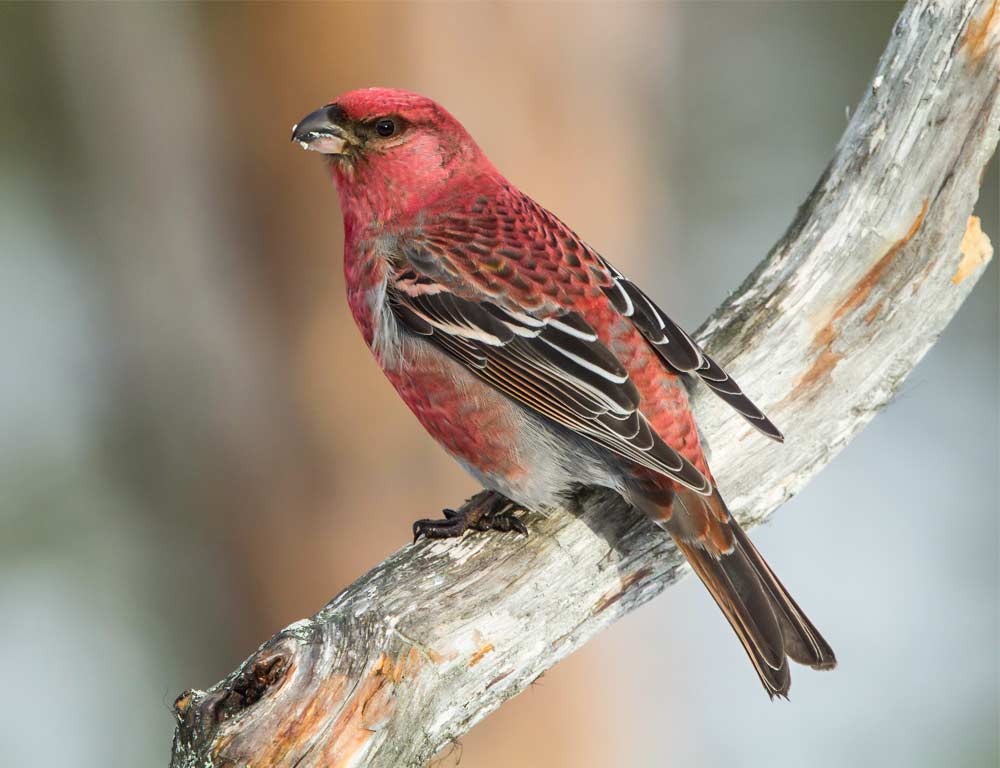
- Scientific name: Pinicola enucleator
- Population: Varies, with periodic irruptions
- Life span: Up to 10 years
- Size: 8 to 10 inches
- Weight: 2.5 to 3.5 ounces
- Wingspan: 13.4 to 15.7 inches
- Status: Least Concern
The majestic Pine Grosbeak (Pinicola enucleator) occasionally graces Michigan during irruption events.
These events lead to variable population numbers, as the grosbeaks follow the availability of their primary food source, which includes various seeds and berries.
With a size ranging from 8 to 10 inches, these chunky finches boast a robust build. Males exhibit a rosy-red plumage, while females display a more muted and streaked appearance.
Pine Grosbeaks inhabit coniferous forests and open woodlands. Their nests are constructed in trees, and their breeding habits are influenced by food availability.
Despite their imposing size, Pine Grosbeaks are often approachable and may visit bird feeders during winter when natural food sources are scarce.
With a potential lifespan of up to 10 years, the Pine Grosbeak’s sporadic visits to Michigan contribute to the region’s birding allure, providing a unique and picturesque addition to the avian landscape.
4. Evening Grosbeak

- Scientific name: Coccothraustes vespertinus
- Population: Varies, with periodic irruptions
- Life span: 10 years or more
- Size: 6.7 to 8.7 inches
- Weight: 1.5 to 2.3 ounces
- Wingspan: 11 to 14 inches
- Status: Least Concern
The Evening Grosbeak (Coccothraustes vespertinus) is a stunning visitor to Michigan, with its striking yellow and black plumage making it stand out.
These grosbeaks are known for their nomadic tendencies, and their population in a region can vary due to periodic irruptions driven by food availability. With a substantial size ranging from 6.7 to 8.7 inches, Evening Grosbeaks primarily feed on seeds, fruits, and insects.
They are particularly fond of sunflower seeds, making them frequent visitors to bird feeders. Their strong bills are well-suited for cracking open seeds. Nesting in coniferous trees, these grosbeaks demonstrate social behavior, often forming large flocks.
Their cheerful calls contribute to the lively ambiance of Michigan’s woodlands. Evening Grosbeaks have a relatively long life span, living 10 years or more.
As charismatic guests to the state, Evening Grosbeaks bring both visual and auditory delight, making them a cherished part of Michigan’s birding experience.
5. Common Redpoll

- Scientific name: Acanthis flammea
- Population: Varies, with periodic irruptions
- Life span: 2 to 4 years
- Size: 4.7 to 5.9 inches
- Weight: 0.4 to 0.7 ounces
- Wingspan: 7.5 to 9.1 inches
- Status: Least Concern
The Common Redpoll (Acanthis flammea) is a delightful and petite finch that occasionally graces Michigan, especially during irruption events. With a size ranging from 4.7 to 5.9 inches, these birds are easily recognizable by their crimson crowns and streaked plumage.
Adaptable to various environments, Common Redpolls are often found in open woodlands, tundra, and scrubby areas. Their nomadic behavior is influenced by the availability of their preferred food sources, including birch and alder seeds.
These finches exhibit social behavior, forming small flocks during migration. Nests are typically constructed in shrubs or trees, using a combination of twigs, grass, and feathers.
With a life span of 2 to 4 years, Common Redpolls contribute to Michigan’s avian diversity, providing birdwatchers with the joy of observing these charming and acrobatic finches.
6. Pine Siskin
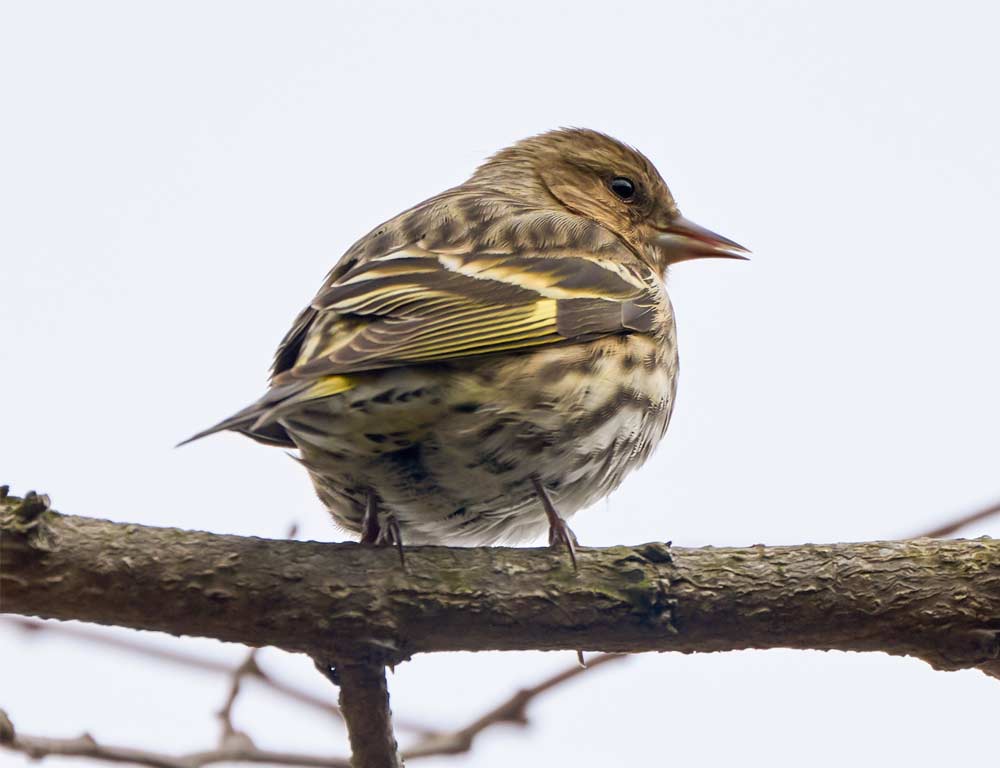
- Scientific name: Spinus pinus
- Population: Varies, with periodic irruptions
- Life span: 6 to 8 years
- Size: 4.5 to 5.5 inches
- Weight: 0.4 to 0.7 ounces
- Wingspan: 8 to 9 inches
- Status: Least Concern
The Pine Siskin (Spinus pinus) is a small and lively finch that occasionally visits Michigan, especially during irruption events.
With a size ranging from 4.5 to 5.5 inches, these birds have a streaked and mottled appearance, blending well with their woodland habitats.
Pine Siskins are highly nomadic, and their populations can fluctuate based on the availability of conifer seeds, their primary food source.
These finches exhibit acrobatic flight patterns and are often found in flocks, creating a dynamic and energetic atmosphere. Nests are typically built in coniferous trees, and their breeding habits are closely linked to the abundance of seeds.
With a 6 to 8 years lifespan, Pine Siskins contribute to Michigan’s birding scene, adding a touch of agility and charm to the diverse array of finches in the region.
7. Hoary Redpoll
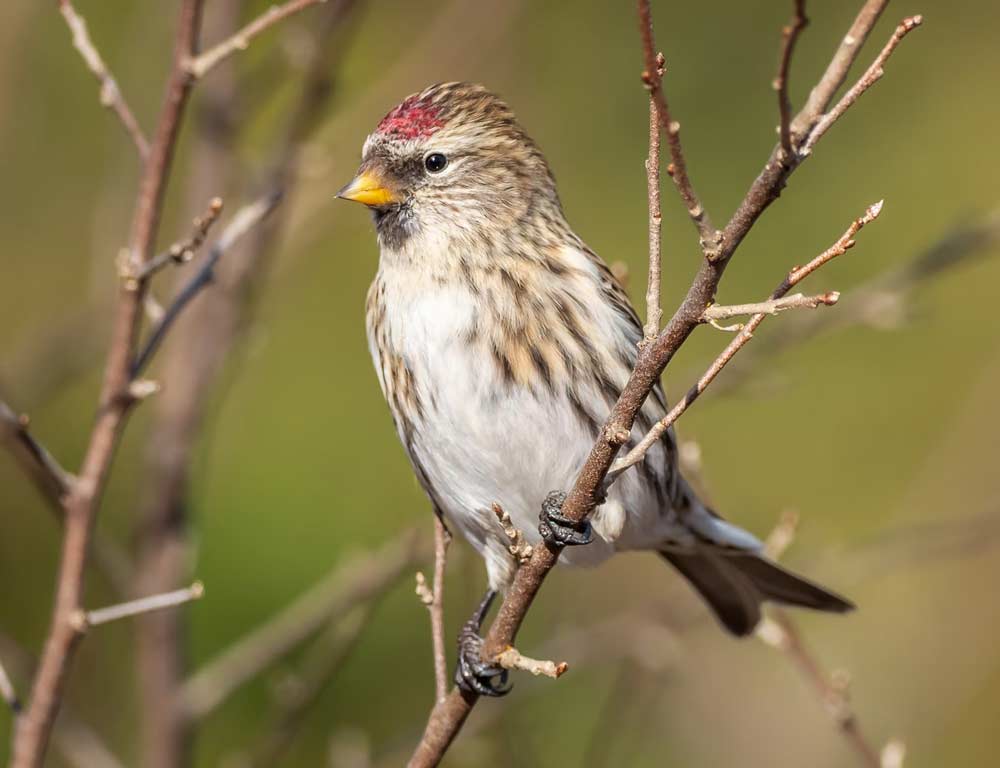
- Scientific name: Acanthis hornemanni
- Population: Generally low, with occasional irruptions
- Life span: 2 to 4 years
- Size: 5 to 5.5 inches
- Weight: 0.5 to 0.7 ounces
- Wingspan: 8.7 to 9.8 inches
- Status: Least Concern
The Hoary Redpoll (Acanthis hornemanni) is a captivating and elusive finch occasionally spotted in Michigan during irruption events.
Similar in appearance to the Common Redpoll, the Hoary Redpoll can be distinguished by its paler plumage and finer streaking.
These small birds, measuring 5 to 5.5 inches, are well-adapted to arctic and subarctic habitats, showcasing remarkable resilience.
Hoary Redpolls primarily feed on seeds, preferring birch and alder seeds. Their nomadic behavior is influenced by the availability of these food sources.
Despite their seemingly delicate appearance, these finches endure harsh winter conditions. Nests are constructed in low vegetation, and their breeding habits are adapted to the Arctic tundra.
With a 2 to 4 years lifespan, the Hoary Redpoll’s occasional presence in Michigan adds a rarity and excitement to the state’s birdwatching community.
8. White-winged Crossbill
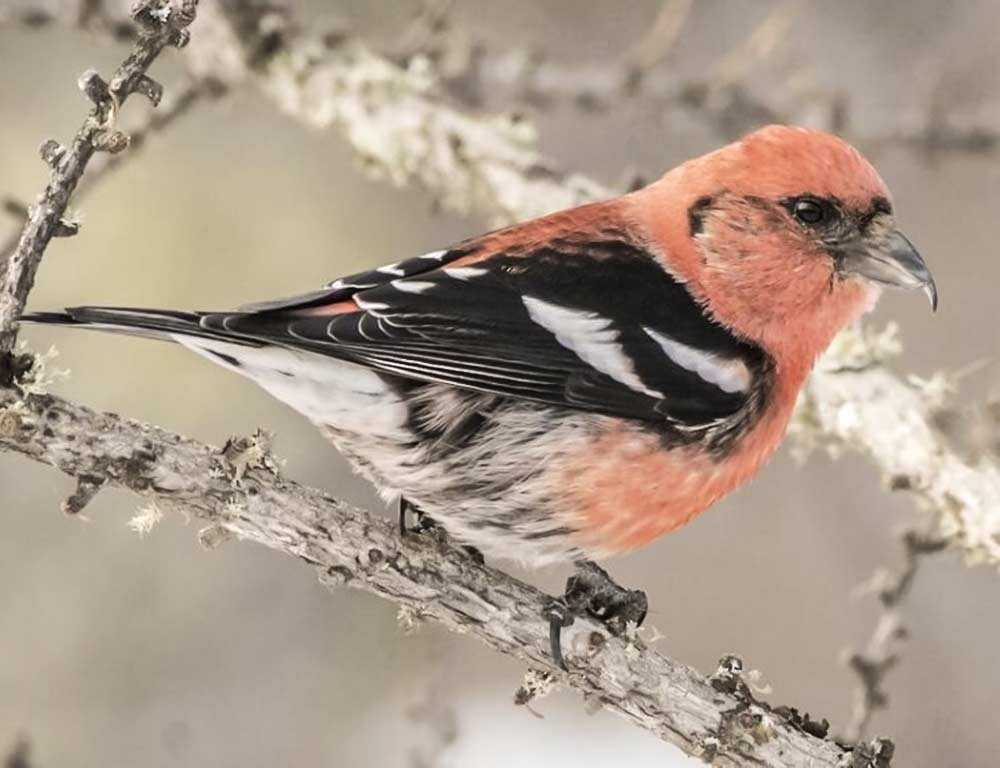
- Scientific name: Loxia leucoptera
- Population: Varies, with regional fluctuations
- Life span: 2 to 4 years
- Size: 6.3 to 7.5 inches
- Weight: 1 to 1.5 ounces
- Wingspan: 10.6 to 11.8 inches
- Status: Least Concern
The White-winged Crossbill (Loxia leucoptera) is an intriguing finch species that occasionally graces Michigan. Recognized for its distinctive crossed bill, which aids in extracting seeds from conifer cones, these birds display remarkable adaptability.
With a size ranging from 6.3 to 7.5 inches, White-winged Crossbills are often found in coniferous forests and open woodlands. Their population varies based on the availability of cone crops, leading to regional fluctuations.
These finches showcase unique feeding behavior, using their specialized bills to access seeds that are typically inaccessible to other birds. Their nomadic tendencies are driven by the distribution of coniferous trees and cone crops.
Nests are constructed in conifer branches, and their breeding habits are influenced by the abundance of suitable cone-bearing trees.
With a lifespan of 2 to 4 years, the White-winged Crossbill’s occasional visits to Michigan contribute to the state’s diverse avian landscape, providing birdwatchers with a glimpse of their specialized feeding techniques and distinctive appearance.
9. American Goldfinch

- Scientific name: Spinus tristis
- Population: Common and widespread
- Life span: 6 to 8 years
- Size: 4.3 to 5.5 inches
- Weight: 0.4 to 0.7 ounces
- Wingspan: 7.5 to 8.7 inches
- Status: Least Concern
The American Goldfinch (Spinus tristis) is a vibrant and common Michigan resident known for its bright yellow plumage. These finches are easily recognizable with their small size, pointed bills, and cheerful songs.
With a life span of 6 to 8 years, American Goldfinches are well-adapted to various habitats, including gardens, meadows, and open woodlands. Their diet primarily consists of seeds from plants like thistles and sunflowers.
The American Goldfinch’s plumage undergoes a striking transformation, with males displaying brilliant yellow feathers during the breeding season and transitioning to a more muted appearance in winter.
Nesting in trees and shrubs, these finches construct cup-shaped nests using plant fibers and down. Their breeding habits are closely tied to the availability of seeds for their young.
These sociable birds often form flocks, creating a lively atmosphere with their vibrant colors and melodious calls. Their frequent visits to bird feeders make them a favorite among birdwatchers in Michigan.
10. Red Crossbill
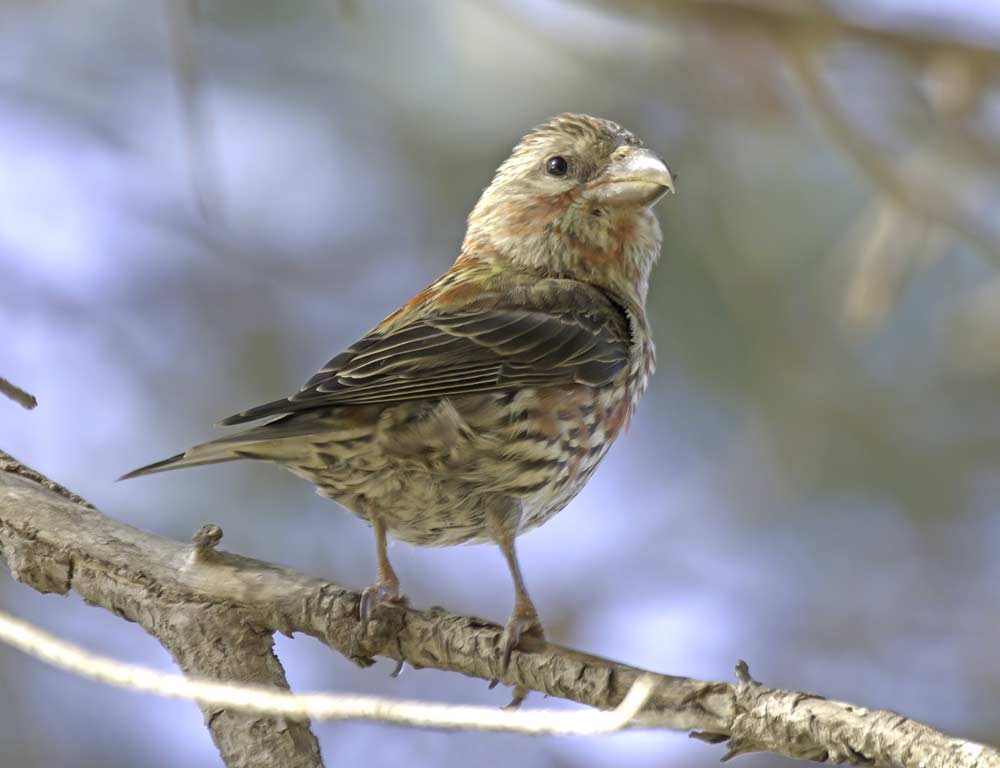
- Scientific name: Loxia curvirostra
- Population: Varies, with regional fluctuations
- Life span: 2 to 4 years
- Size: 5.5 to 7.9 inches
- Weight: 1 to 1.6 ounces
- Wingspan: 9.8 to 11.8 inches
- Status: Least Concern
The Red Crossbill (Loxia curvirostra) is a distinctive finch known for its unique bill, which crosses at the tips. This specialized bill allows them to extract seeds from conifer cones efficiently.
With a size ranging from 5.5 to 7.9 inches, Red Crossbills showcase regional variability in their appearance, with different populations adapted to specific coniferous tree species.
Their nomadic behavior is closely linked to the distribution of conifer forests and the availability of cone crops. These finches form small family groups or larger flocks and can be found in coniferous forests, making Michigan’s woodland habitats suitable for their visits.
Nesting occurs in conifer branches, and their breeding habits are influenced by the abundance of cone-bearing trees. The Red Crossbill’s lifespan is typically 2 to 4 years, with population dynamics responding to cone crop fluctuations.
Observing Red Crossbills in Michigan provides birdwatchers with a unique opportunity to witness their specialized feeding behavior and adaptability to different coniferous environments.
11. Rose-breasted Grosbeak
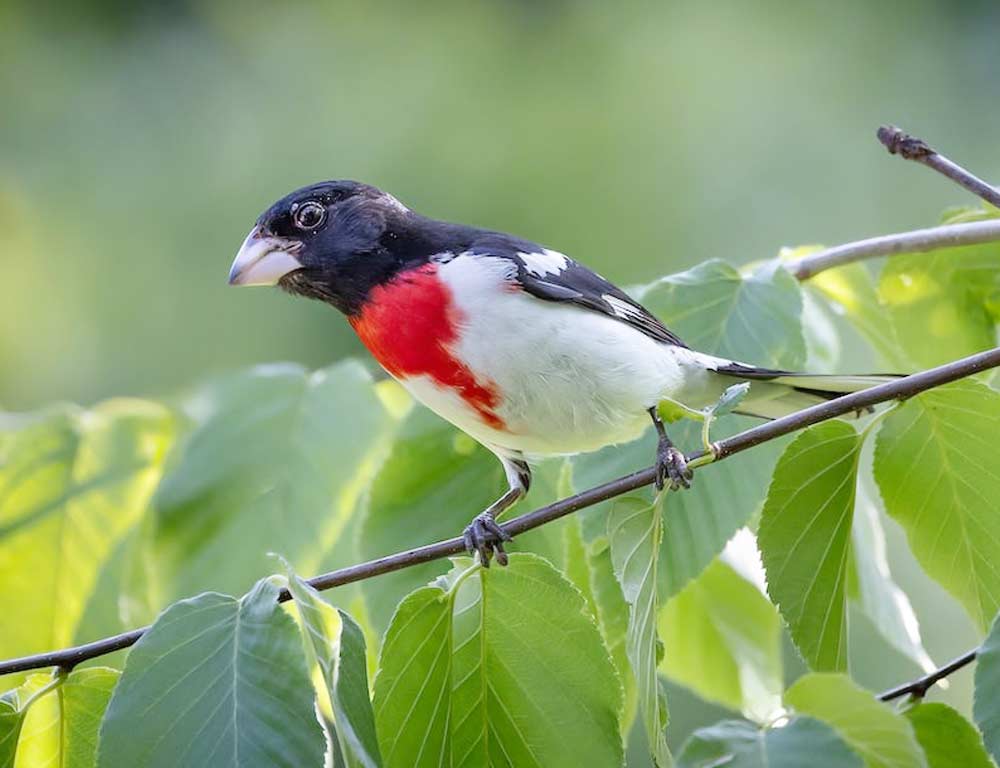
- Scientific name: Pheucticus ludovicianus
- Population: Stable, common in suitable habitats
- Life span: 4 to 5 years
- Size: 7 to 7.9 inches
- Weight: 1.4 to 2.0 ounces
- Wingspan: 11 to 12.6 inches
- Status: Least Concern
The Rose-breasted Grosbeak (Pheucticus ludovicianus) graces Michigan with its striking black and white plumage, accented by a vibrant rosy-red patch on its chest.
With a size ranging from 7 to 7.9 inches, these grosbeaks are common in the state’s woodlands, gardens, and shrubby areas.
Their diet includes a variety of seeds, insects, and fruits. Rose-breasted Grosbeaks are known for their melodious songs, adding to the auditory richness of Michigan’s avian landscape.
With a 4 to 5 years life span, these grosbeaks exhibit sexual dimorphism, with males displaying the characteristic rosy-red “bib.”
Nests are built in trees, shrubs, or vines, and males and females contribute to the construction of the nest. Breeding habits are influenced by the availability of suitable nesting sites and food sources.
Rose-breasted Grosbeaks are often seen at bird feeders, making them a delightful sight for bird enthusiasts. Their stable population in Michigan contributes to the state’s biodiversity, making them a cherished part of the local birdwatching experience.
Wrapping Up
In the tapestry of Michigan’s avian world, finches stand out with their vibrant hues and melodious songs, creating a captivating symphony.
As we explored the diverse lifestyles of House Finches, Purple Finches, Pine Grosbeaks, American Goldfinches, Red Crossbills, and Rose-breasted Grosbeaks, we witnessed nature’s resilience and adaptation.
Michigan’s woodlands, gardens, and skies host a breathtaking variety of these feathered wonders, contributing to the state’s biodiversity.
Whether glimpsing the nomadic patterns of crossbills or delighting in the familiar sight of goldfinches at feeders, the finches of Michigan embody the beauty and dynamic spirit of the natural world. Thank you so much.